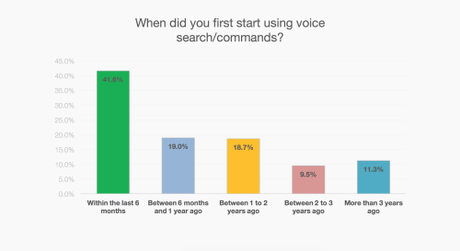
Here we are in 2015, and many of the top holiday gifts in the electronics category have one thing in common: they’re voice-driven. Earlier this month, Amazon Echo was named one of Oprah’s “Favorite Things.” A voice-driven toy for the younger set, Mattel’s “Hello Barbie,” has stirred up controversy but looked very impressive in demos. The popular new Apple TV is reliant on voice navigation, going as far as to reject any apps that aren’t compatible with its Siri remote. Voice-driven technology took a while to get this good, but we’re finally here.
Four years ago, when Siri was first introduced to the iPhone, to mixed critical reactions, it would have been hard to imagine a voice take-over like this. However, due to new breakthroughs in artificial intelligence, speech recognition accuracy has skyrocketed – in fact, eclipsing all progress made over the previous 20 years combined. Improvements in natural language understanding – the ability to understand the meaning of utterances – have followed closely on speech rec’s heels, leading to a level of quality in artificial voice interactions that is utterly new.
We can’t be sure they’re all reading the Technology section, but the rapid progression of speech technology has not escaped the notice of tens of millions of consumers. In an October 2015 study of 1800 US smartphone users, we found that more than 60% use the voice assistant feature (Siri, OK Google, Cortana) that is available on their phones. Interestingly, out of that number, 61% started using voice assistants within the past year, and more than 40% started within the past 6 months alone. Considering that nearly two-thirds of Americans own smartphones, this suggests a lot of people have been getting turned onto voice technology very quickly!

Since the beginnings of home computing, it was a given that computer content would be mainly interacted with via mouse-clicks and keyboard-taps – until the smartphone boom, that is, which rapidly popularized the capacitive touchscreen. A lot can be done with a touchscreen, but the experience of typing on a virtual keyboard remains cumbersome, even with innovations like predictive text. This is why a mounting tide of users are adopting voice: as the technology gets more sophisticated, voice becomes the practical solution for hands-free input, and is often the fastest way to get your point across.
Think about it: it takes about 7 seconds to say into a microphone “show me men’s black Adidas shoes for under $75,” but getting the same result by navigating menus in an app can take three times as long. Moreover, as the Internet of Things continues to establish itself, there will be an increasing number of devices out there that do not – cannot – feature a graphical user interface or virtual keyboard at all. Voice will be the only way to communicate with such devices. It is fortunate that modern speech technology is finally up to the challenge.
In 2016, we predict the voice trend to continue to gain momentum in consumer electronics as well as voice-enabled apps. Apple, Amazon and Google have paved the way but 2016 will be the year of democratized voice for all – from small Silicon Valley startups to large, public companies. Of course, not everyone will be using voice, but it is easy to surmise from our study – and other studies like Google’s – that the future of voice as an interface is burning very bright indeed.
See more from the MindMeld study here.
